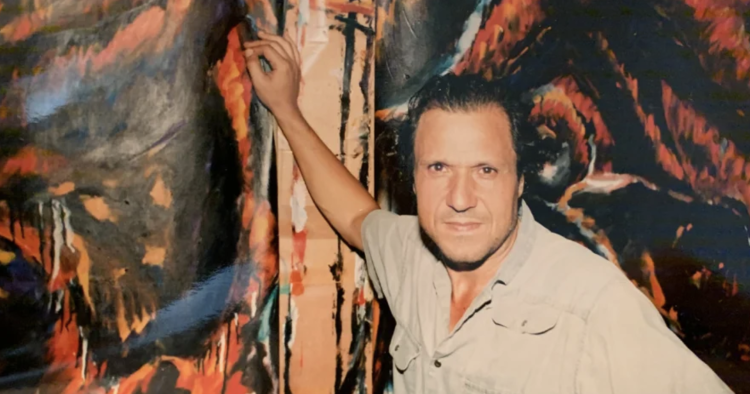The June 5 attack on the United States Embassy in Beirut predictably prompted a flurry of press reports and shone a renewed spotlight on Lebanon’s multiple, interlocking crises that formed the backdrop to this tragic incident tying the two countries together. These reports, however, overlooked an even more historic event linking the US and Lebanon that took place in the Lebanese capital on the same day as the attack: the opening of the first art exhibition in Lebanon of Nabil Kanso (1940-2019) — the Lebanese-born American artist, whose moving pieces exploring his native country and the contemporary world are only now getting the recognition that they richly deserve. Indeed, Kanso’s works are also on display at the Institute of Arab and Islamic Art in New York City (IAIA) and the High Museum in Atlanta, GA; and they will be shown at Michigan State University’s Eli and Edythe Broad Art Museum in 2025.
The night before the opening of Kanso’s Beirut show, I spoke with Saleh Barakat, a leading figure in the Lebanese and Arab art worlds. We had met earlier that day at an academic conference at the Orient-Institut Beirut on Arab artistic hubs. As we enjoyed a picturesque Beirut sunset at a large restaurant overlooking the city’s famed Al Rouché (Pigeon Rocks), Barakat explained to me that he had known Kanso well, praising his integrity as an artist while describing the fierce challenges that he sometimes faced getting his work exhibited. After all, Kanso’s work, Barakat warned me, is “not easy to view,” adding that “it is not often what sells in the art market.” Still, Barakat had agreed to host a show of Kanso’s artworks at his Beirut gallery drawn from the collection of the Dalloul Art Foundation since he believes that the late artist’s work has enormous value and expresses the contemporary moment — even though his seminal works were produced decades before 2024.
Few works better illustrate Barakat’s insights than the three massive oil canvases that frame Kanso’s Beirut show. The first is the 85-by-109-inch (217-by-277-centimeter) untitled color oil canvas from Kanso’s series on the Lebanon Civil War. It is defined by fighter jet aircraft, a military helicopter, flying birds, a church, a mosque, and a series of humans in distress. Although the painting is from 1983 and implicitly references Israel’s 1982 invasion of Lebanon, it could just as easily portray Gaza after October 2023 or the many other conflicts whose images of death and violence define much of our media landscape.
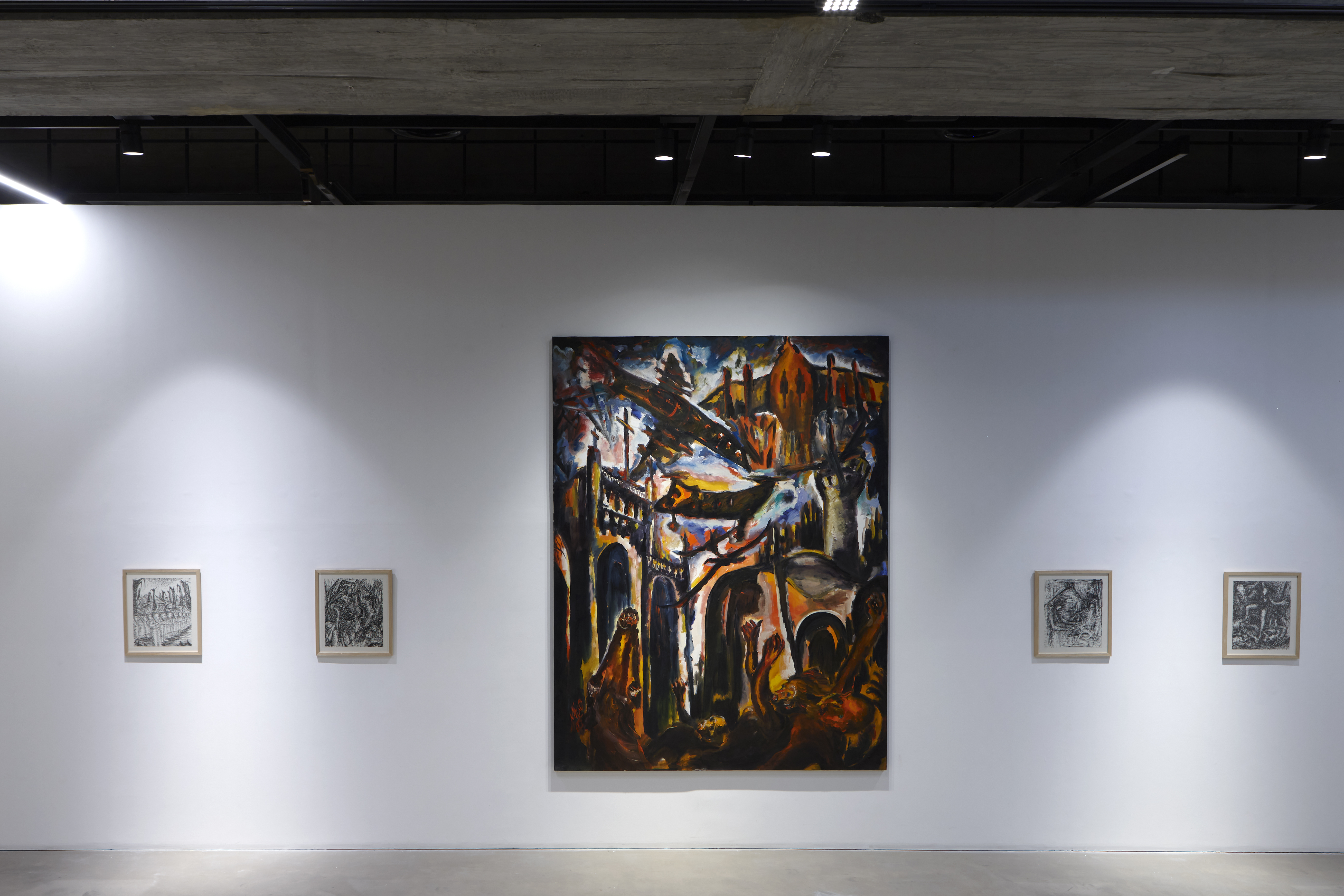
The second piece, “Lebanon 1977: Vortices of Wrath,” from The Split of Life series, is an even larger 120 in x 299 in (310 cm x 716 cm) triptych oil on canvas piece. Although its title references a key early year in Lebanon’s Civil War, it portrays a fiery hellscape filled with chains, male and female humans, a baby, and various mythical figures. Many of these characters are hanging upside down or in contorted positions, threatened by large pits or creatures with skull-like faces. One massive figure appears in the center, in a position akin to Christ on the cross. In addition, there is a colossal orange face that takes up almost an entire panel and looks menacingly at the viewer.
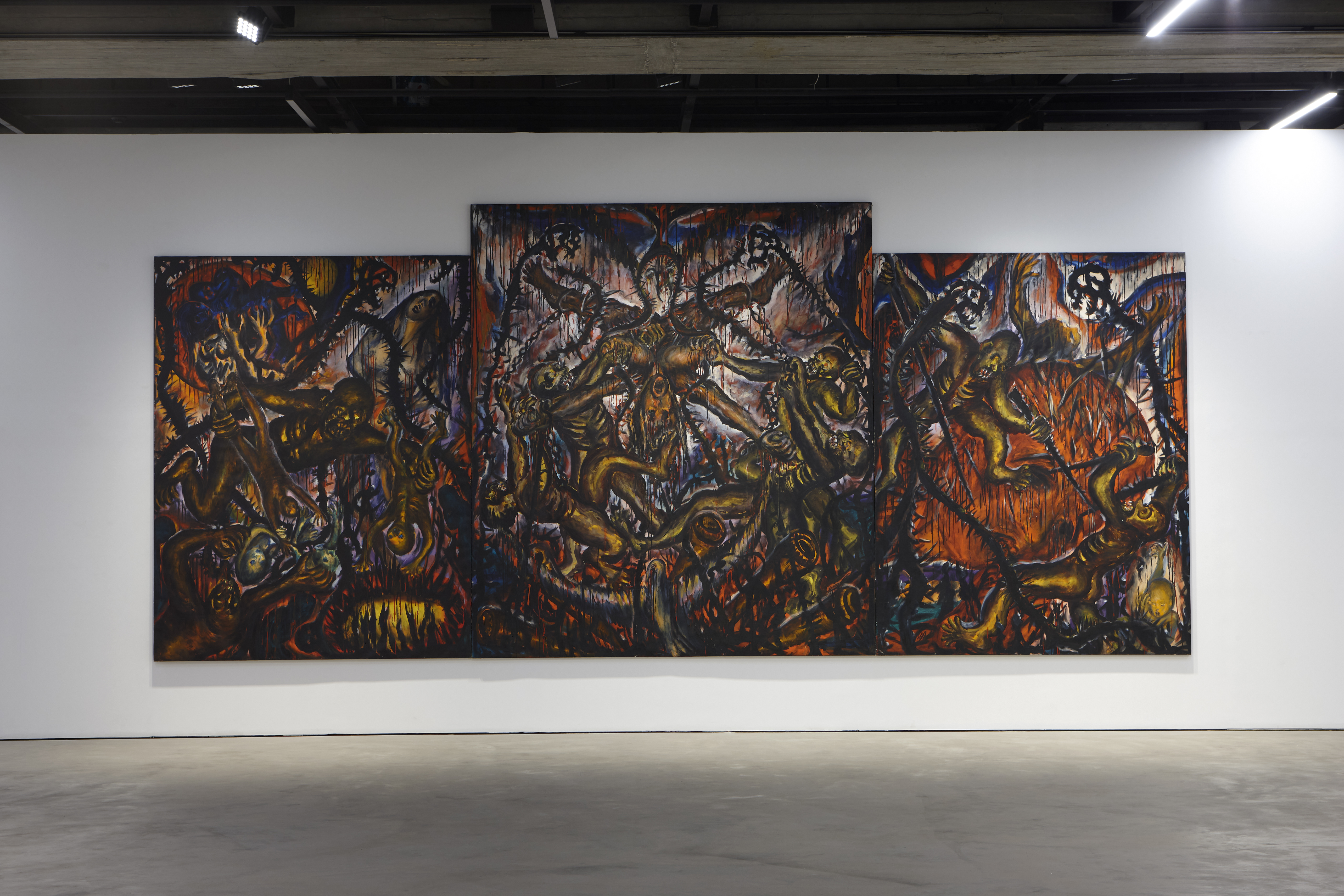
The third piece is a single 122 in x 216 in (310 cm x 550 cm) work: “Blazing Vortices.” Although the subtitle of the piece, “Lebanon Summer of 1982, Sabra and Shatila,” references the Lebanese refugee camps where Maronite military forces massacred Palestinian refugees in 1982 while nearby Israeli military forces failed to intervene, it is not a description of Lebanese history or the Arab-Israeli conflict. Instead, it is an allegory of death and rebirth — themes that Meriam Soltan has, in a recent book on Kanso’s life, linked to the latter’s identity as a Druze.
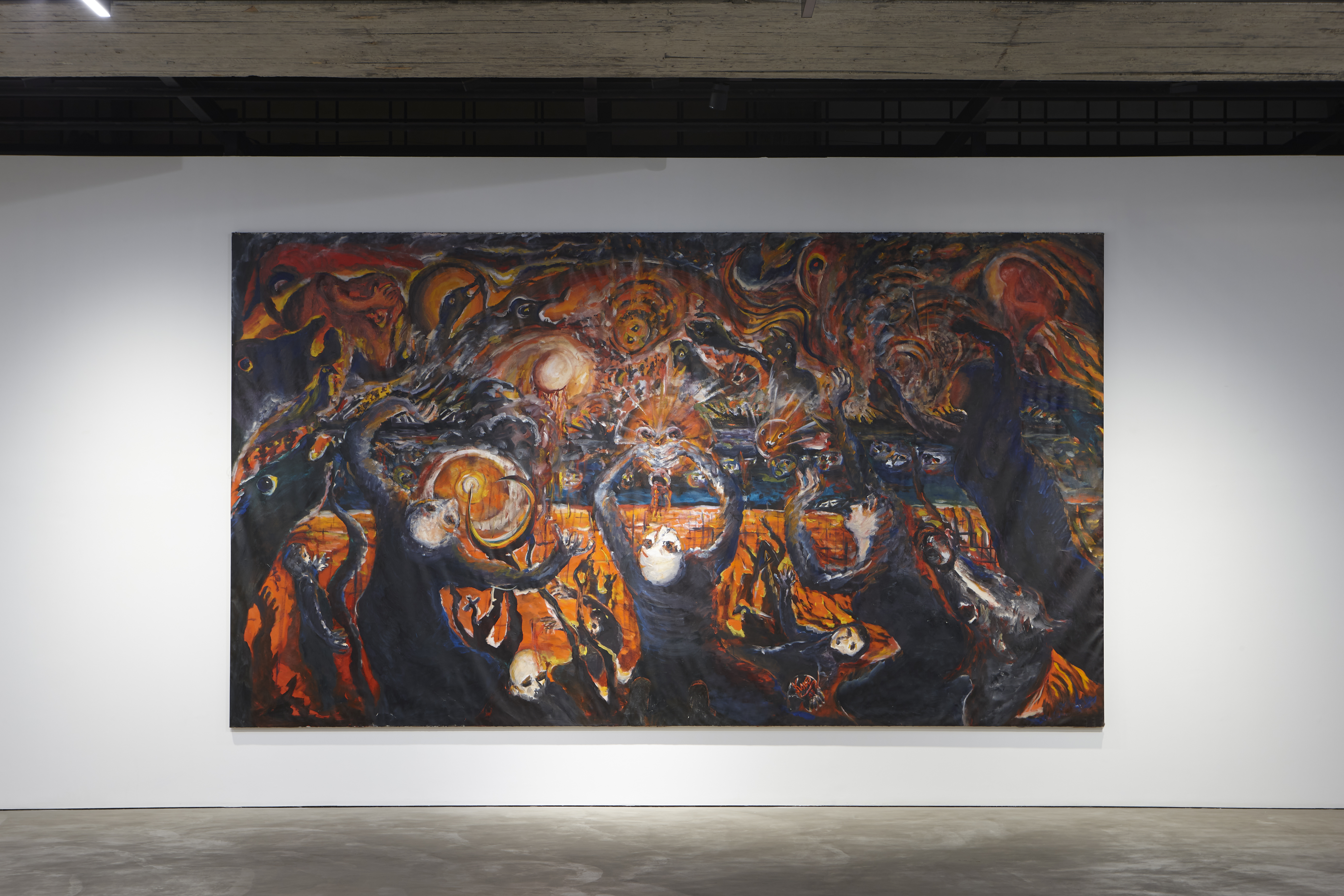
Those themes, as Hatem Alzahrani points out in a recent chapter on the poet Muḥammad al-Thubaytī, are also central to the Tammūzī movement of Arab modernism along with Beirut’s cultural scene throughout Kanso’s youth in the 1950s and 1960s. Indeed, Ali Ahmad Said Esber, the Syrian poet who edited the influential avant-garde/modernist literary magazine Shi’r in the Lebanese capital during this era, adopted the pen name Adonis: a name inspired by the Greek-Phoenician deity associated with death and resurrection.
Throughout “Lebanon Summer of 1982,” one sees a wide range of imagery that could be linked to those themes, including crosses, a crescent moon, a sun, men and women prostrating and praying, a figure drinking what looks to be blood, and the heads of horses. There is also a massive orange eye looking at the viewer, analogous to the face that defines “Lebanon 1977.” A river filled with fish and fish-like mythical creatures cuts the painting in half, suggesting a body of water analogous to the River Styx in Greek mythology.
When one first looks at these works, it is difficult not to be overtaken by the horrific scenes, akin to the darkest works of the Spanish painters Francisco Goya or Pablo Picasso, both of whom Kanso has cited as key influences on his work. Yet Kanso’s vision of darkness is balanced by light and unexpected colors: there are rich blues, purples, reds, turquoises, yellows, whites, and other hues that one does not associate with hellscapes or war zones. As Barakat noted the day after the opening, he had never seen anything like Kanso’s use of color and light during his three-decade career in the Arab art world. In his eyes, the artist’s use of his broad palette creates an effect akin to what one sees in stained-glass windows.
Further contrasting this vision of darkness is Kanso’s humor and sense of the absurd. For instance, his black-and-white ink portraits, which are smaller than his color canvas works, are filled with humans, goblins, devils, and other mythical figures who often grin at the viewer in a menacing way reminiscent of a Cheshire cat. One of the most striking of these works, from the Leaves From the Theater of War series, is 24 in x 18 in (61 cm x 46 cm) and features three grinning goblins who place their hands on a globe. While one might think that this work could be an illusion to Lebanon’s tripartite political system, it and Kanso’s other pieces like it are meant to be part of a universal story about politics and human societies. Kanso makes this clear by the fact that he titled the works, created in the 1980s and early 1990s, in five separate languages: Arabic, English, French, German, and Spanish.
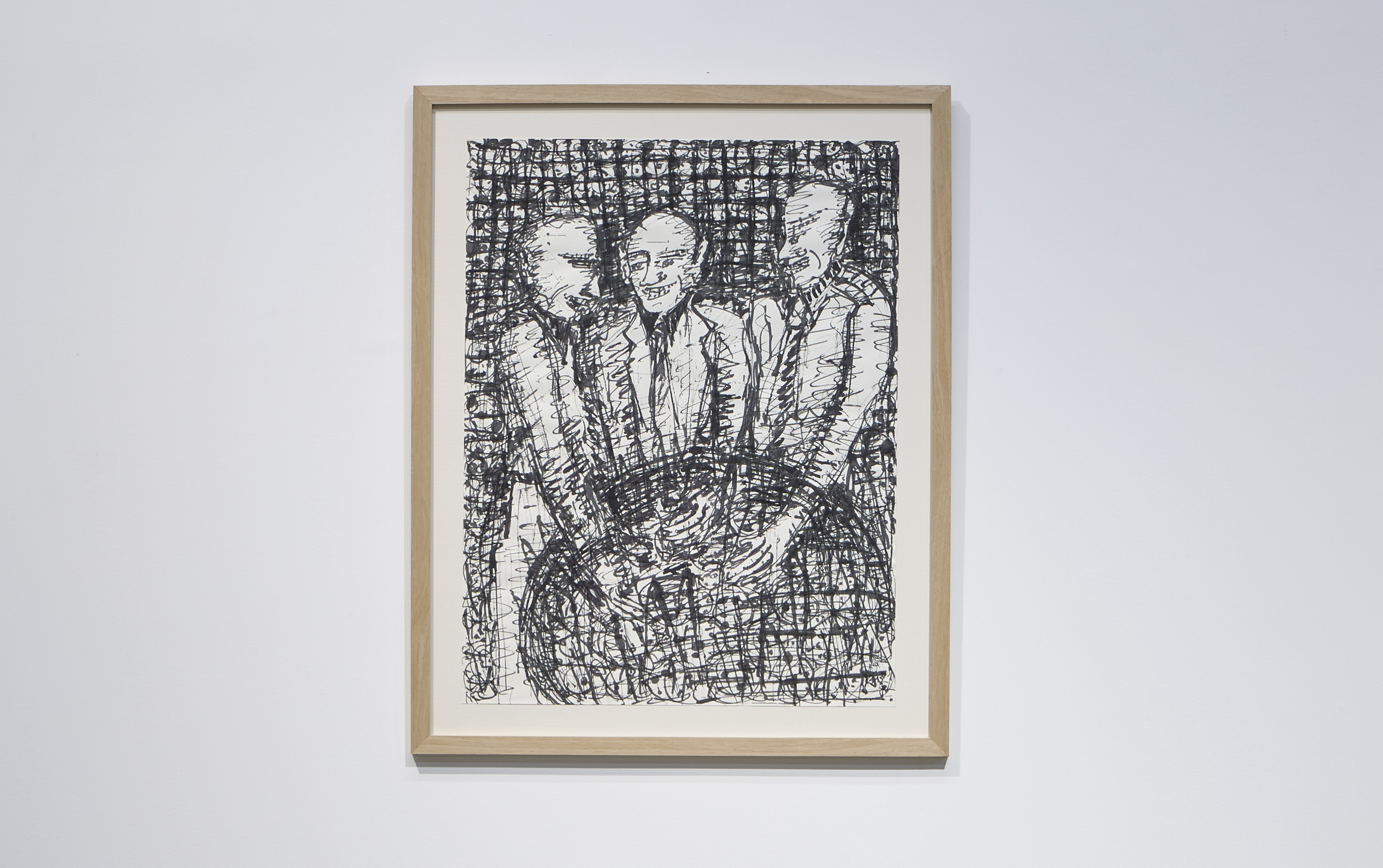
The linkage of Kanso’s work to politics should come as no surprise. As Daniel Kanso, Nabil’s son, explained to me, his father never joined a political party and was not affiliated with any political ideology. But he was engaged in the world and hoped his works would inspire others to look at their world critically and take action. That engagement, in part, reflected the artist’s lived experience in Lebanon and in America. He settled in New York City during the Vietnam War era to study art at New York University (NYU) and later opened his first gallery in the city during the politically tumultuous year of 1968. In 1972, he co-authored, with NYU political science professor Gisbert Flanz, the first English-language translation of the Lebanese constitution. Becoming an American citizen in 1983 was another critical moment for Kanso, compelling him to explore the history and society of his new nation. Indeed, as his son explained to me, throughout the 40 years Nabil Kanso lived and worked in Atlanta, GA, the artist delved into race, gender, Native American history, the Holocaust, the atomic bombings of Hiroshima and Nagasaki, and other complicated themes linked to his new homeland. In 1997, Kanso even corresponded with Hiroshima Mayor Takashi Hiraoka, an activist for nuclear disarmament, about his artworks that were inspired by the historic attack on the city on Aug. 6, 1945.
Nearly six decades after Kanso moved to America and began his career as a visual artist, his work remains enormously important, channeling the zeitgeist of our uncertain and violent era. His large works in particular express the dark, hellish, and dangerous world that many people believe has emerged from the COVID-19 pandemic, the wars in Gaza and Ukraine, and the polarized domestic politics in America and other societies around the world. Yet as dark as Kanso’s vision is, he also reminds us that even the most hellacious of contexts can contain light and the possibility of rebirth and renewal. This message echoes the famous parable of the 17th-century English theologian Thomas Fuller — a man who also lived through an era of disease, violence, and political polarization. “It is said that the darkest hour of the night,” Fuller wrote in 1650, “comes just before the dawn.”
Sean Foley is a professor of history at Middle Tennessee State University and specializes in the history of the Middle East and the cultural, political, and religious trends in the wider Islamic world. He is the author of Changing Saudi Arabia: Arts, Culture, and Society in the Kingdom. For more on his work, see http://www.seanfoley.org.
Photo above: Lebanese-American artist Nabil Kanso stands between two works from his Kuwait series on the Gulf War in the early 1990s. Photo source nabilkanso.org, courtesy of The Nabil Kanso Estate.
The Middle East Institute (MEI) is an independent, non-partisan, non-for-profit, educational organization. It does not engage in advocacy and its scholars’ opinions are their own. MEI welcomes financial donations, but retains sole editorial control over its work and its publications reflect only the authors’ views. For a listing of MEI donors, please click here.













